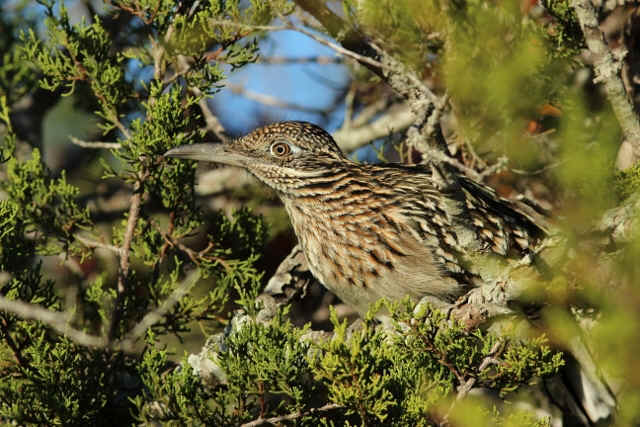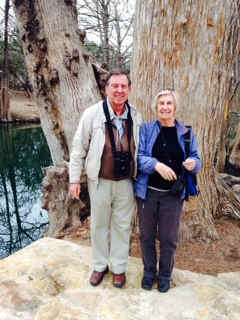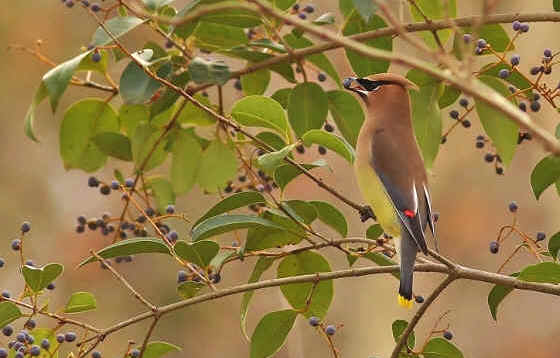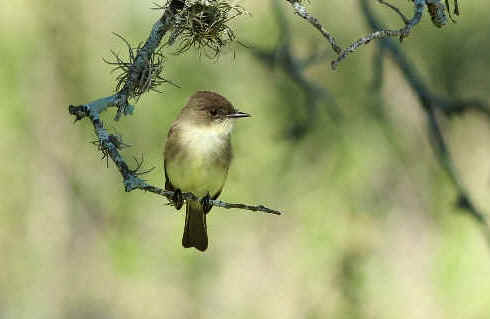
E-mail: font@focusonnature.com
Phone: Toll-free in USA 1-888-721-3555
or 302/529-1876
 |
PO
Box 9021, Wilmington, DE 19809, USA E-mail: font@focusonnature.com Phone: Toll-free in USA 1-888-721-3555 or 302/529-1876 |
THE FOCUS ON NATURE TOUR IN TEXAS
MARCH 2014
"Idyllic,
Iconic, and Utopian Texas"
with
some things ancient and others, of course, present-day

A Greater Roadrunner,
one of the many birds we enjoyed during
our March 2014 tour in Texas
(photo by Rhett Poppe, of Wimberley, Texas)
Links:
Birds & Other Wildlife during our Texas Tour in March 2014
A List & Photo Gallery of Texas Birds, in 2 parts
Texas Mammals
(with some photos)
Upcoming FONT Birding & Nature Tours in Texas
The following narrative of the FONT March
2014
tour in Texas was
written by Armas Hill, the tour leader:
Texas
really is a great place to see birds and other nature.
Being the largest of the 48 contiguous states, there is a lot to see there in
the big and varied state of Texas, no matter
either when or where we would have decided to visit.
But we chose the month of March, as it is
good for seeing Whooping Cranes before they depart to go north to Canada,
and for seeing the Golden-cheeked Warbler when it arrives at its breeding
sites, having come from Mexico and Central America.
Those two birds, both endangered, were the book-ends of the FONT
March 2014 Texas Tour, with cranes seen during our first
full-day and the warbler during our last.
And in between there was so much, with some aspects of the tour, as noted in the
above title, being: idyllic,
iconic, and utopian.
The word "idyllic", as defined in the dictionary, means
"pleasing, or picturesque in natural simplicity".
The first known use of that word in the English language was back in 1856.
The history of Texas, under any one of six
flags, goes back further than that. The
Spanish flag was the first to fly in Texas, from 1519 to 1684. The French
flag flew from 1684 to 1690.
The Spanish flag flew again from 1690 to 1821, until the Mexican
flag flew over what is now Texas from 1821 to 1836.
Texas was a country, the Republic of Texas,
with its own flag, from 1836 to 1845.
And still, at that time, there was no word "idyllic".
In 1845, Texas became a state in the US, and has been since except during the
years 1861 to 1865 when the flag of the Confederate
states flew over Texas.
These days, as during our March 2014 tour,
one can't help but notice, as one travels along the Texas
highways, two flags prominently flying -
that of the US, and just about as much, that of the state.
Generally, in other parts of the US, state flags are not as prominently flown.
We were told that the small town of Three Rivers
(or "Tres Rios") south of San Antonio
was, even just a few years ago, an idyllic place.
About half-way between the Gulf Coast (where
we had seen the Whooping Cranes) and the "Hill
Country" (where we were to see the Golden-cheeked Warbler),
it was a perfect place, logistically to spend a night. And the nearby Choke
Canyon would be a good place, geographically, for good, anticipated
morning birding.
But Three Rivers in 2014, regardless what it
may have been in the past, was not "idyllic".
We learned, when we got off the interstate, a few miles from town, that some
brand-new hotels had just been made. Odd, because there was nothing, truly
nothing by the interstate exit, and that's how it had been for miles along
the highway, with just empty agricultural fields.
We found, along the smaller road to and from Three Rivers, a parade of large
trucks.
Three Rivers was now an oil boom town.
After dark when we arrived at one of those brand-new hotels, outside our window,
the skyline of Three Rivers was a big oil refinery, lit with many lights.
The next morning however, at Choke Canyon,
not many miles away, we did have the anticipated good morning birding as we had
envisioned, with Green Jays, Crested Caracaras, Audubon Oriole, Pyrrhuloxia,
Vermilion Flycatcher, Verdin, Cave Swallows, warblers, wrens, kinglets, and Greater
Roadrunner giving us a wonderful time.
It doesn't get much more "idyllic", or "pleasing in natural
simplicity".
In the very nice town of Wimberley, our base
for a few days in the "Hill Country",
and the Edwards Plateau, we stayed at a nice
place, indeed, by a creek. Called the Cypress Creek,
there were, by it, trees so-named, along with nearby Live Oaks and Ashe
Junipers on the rolling hills. Not only was the town nice, the area was most
pleasant, and our accommodations were fine indeed.
In a magazine in town, a guide to what was about, the place where we stayed, the
7 Acre Ranch, was actually described as "iconic".
The definition of that word is "pertaining to, or characteristic of an
icon" with "an icon" having the meaning of "an
emblem, or symbol, or something classic".
Well, it was true. The ranch, with its cabins, had been there for a while and
did have some history.
Around the corner from where we stayed there was a lot of history, in one
building, the "Cowboy Museum",
filled, yes literally filled, with probably the finest collection of "Old
West" memorabilia in private hands. In it were such things as Doc
Holliday's desk and dentures.
But it is proprietor of the place, the 90 year-old Jack Glover, who is really
the best "collector's item" in the place.
He has Cherokee roots and was related to Will Rogers, so he says. He has so many
stories.
But from the many items on display, it can be seen that he really did know and
was known by many of the actors who, over the years, were in Western movies and
television shows.
Jack opened his first trading post in 1949, and back in 1966 he wrote what
became, and still is, the definitive book about barbed wire. Called the "Bobbed
Wire Bible", it has been the main reference on the subject.
When we were there, his grand-daughter was also. She had come from out-of-town,
and had never seen all of the "stuff" in the store. She had seen much
of it elsewhere, earlier, she said, but not as much as there was that day. One
can just imagine what she thought as she looked about.
But, really there was so much of interest at one place, and with a good and
interesting man, who is, himself, "iconic".
Back around the corner, something else about the 7 Acre Ranch deserves a
mention. In passing, I said to one of the owners that during our first night
there, the remote did not work for television.
I know we don't go on tours for the television, but I simply mentioned it.
Well, late the second day, when we returned, we found that the owner had gone to
the store during the day and there was a spanking-new flat-screen TV in the
room.
Now, that's "iconic", not just a "classic" occurrence, but
one that's "classy".
The large trees, near our hotel, along the Cypress Creek were
Bald Cypresses.
They are deciduous trees, and hence their common name.
Bald Cypresses can be very large. They are closely related to the very
big Redwood Trees in the West.
Of any Eastern tree, the Bald Cypress has the largest recorded trunk
diameter of over 17 feet.
Actually, the largest recorded trunk diameter of any species of tree anywhere is
that of a Montezuma Bald Cypress in Oaxaca, Mexico. That diameter:
35.5 feet.
The Montezuma Bald Cypress, which occurs in Texas as well as in Mexico,
is said to be a variant of the Common Bald Cypress.

Armas Hill & Johnna
Robinson
by the base of a Bald Cypress Tree
during the FONT March 2014 Texas Tour
Not only can it be big, the Bald Cypress can be old. The longest living
tree in the East is a Bald Cypress, up to 1,622 years of age.
And so the species is an interesting tree to say the least - one of a few
interesting tree species during our tour.
A notable big and old Texas Live Oak Tree was one outside the Alamo
in San Antonio, where we made a mid-day stop
as we went through the city.
The isolated "Lost Maples" at only one place in the Texas "Hill
Country" were of another species of interest, the Uvalde Big
Tooth Maple, or Canyon Maple. Mostly, that species is in isolated
pockets in the western Rocky
Mountains.
Texas is famous for wildflowers,
where, at certain times with certain conditions, there can be many. That was not
the case during our March 2014 tour. It was
still a little too early in the spring.
But we did make a roadside stop, not far from Three Rivers where there was a
patch of Bluebonnets.
The Texas Bluebonnet is the Texas state flower. Well, not exactly, as it
is one of six species all designated as the state flower, all in the Lupinus
genus, all bluebonnets.
The 6 Lupinus species occurring in Texas are:
Lupinus concinnus, the Annual Lupine
Lupinus havardi, the Big Bend Bluebonnet
Lupinus perennis, the Perennial Bluebonnet
Lupinus plattensis, the Dune Bluebonnet
Lupinus subcarnosus, the Sandyland Bluebonnet
Lupinus texensis, the Texas Bluebonnet.
The Dune Bluebonnet, also known as the Platte River Bluebonnet, is
very rare in Texas, only in the far-northern part of the state.
The Big Bend Bluebonnet, as its name implies, is in Texas only in the
far-western part of the state.
Neither the Annual Lupine nor the Perennial Bluebonnet are common
in Texas.
Only two of these species are endemic to Texas, the Sandyland Bluebonnet
and the Texas Bluebonnet.
In 1901, the Sandyland Bluebonnet was adapted as the state flower of
Texas, but because it is not as showy as the Texas Bluebonnet, popular
opinion prompted the state to make all of the Lupinus species occurring
naturally in Texas as the state flower.
That 1971 decision ended the dispute as to the real Texas state flower, and gave
Texas at that time 5 (now 6) species of bluebonnets designated as its
official state flower.
The species that we saw, roadside, was the Texas Bluebonnet, Lupinus texensis.
At the source of the Cypress Creek in Wimberley,
there is an interesting place called Jacob's
Well.
Thousands of gallons of water per minute spring up there from a long underwater
cave, as the creek begins on its way.
The area is predominantly limestone, and as we walked along the creek by its
source, the naturalist brought to our attention a number of interesting
fossils from a long, long time ago.
Among them was an interesting one called the Texas Heart Shell, with the
scientific name Protocardia texana.
It was from the Lower Cretaceous Period,
from 100 to 140 million years
ago.

A Texas Heart Shell,
a fossil from many, many years ago
(photo by Johnna Robinson)
As hard as it may be to really comprehend, there was something else during the
tour was out and about during the Lower Cretaceous
Period, the Whooping Crane.
As we saw a particular pair of them during our tour, at the Aransas
National Wildlife Refuge, we watched the birds walking along the edge
of bay, feeding, and then standing in the shallow water.
It really was incomprehensible to us that such birds were walking, feeding, and
roosting, way back when, in much the same way, millions of years in the past.
Those nearly all-white, tall birds looked so stately. The Whooping Crane
is the tallest of the North American birds, about 5 feet high when standing
erect.
And, even though they have been on Earth for so many millions of years, during
the past century, the Whooping Crane has been among the rarest of birds
anywhere.
It nearly became extinct by the mid-twentieth century. When really thinking
about how long the bird has been on Earth, it is incredible that just a few
hundred years with man could nearly bring about its demise.
It was on the brink of disappearing forever in about 1940
when the total Whooping Crane population was only 15 individuals.
All of those dozen-plus birds wintered at the Aransas
Wildlife Refuge along the Texas Gulf
Coast, after traveling about 2,500 miles from where their nesting
area in Canada.
By 2008, the Whooping Crane population
had reached 270 individuals.
It was still the rarest of the 15 species of cranes in the world, followed in
2nd and 3rd place by the Red-crowned, or Japanese Crane, and the Siberian
Crane, both birds of Asia (and both seen during FONT tours in Japan - the
Red-crowned every time, and the Siberian rarely).
But back with the rarest of all, the Whooping Crane, there was, just
after the beginning of this century, an average annual growth in the population
of 4.6 per cent.
In May 2010 (not very long ago),
there was a modern-day record of 74 nesting pairs.
In July 2010, the total wild population
of Whooping Cranes was said to be 383.
The captive population that year was 152 birds.
Thus, at the beginning of this decade, a bird that was barely hanging on, about
half a century prior to that, with only 15 individuals, had a total
population of 535 birds, both wild and captive.
And still, the Whooping Crane continues to be the rarest of the world's
cranes, with still with only one self-sustaining wild population
that travels about 2,500 miles twice a year, in a corridor only 220 miles wide,
between Saskatchewan and Texas.
In recent years, other smaller populations have been captive-raised,
non-migratory birds in central Florida, and
a small migratory group, that starting in 2001 traveled, with the aid of man,
round-trip each year between Wisconsin and Florida.
The last remaining wild bird in the re-introduced Rocky Mountain population died
in 2002.
Seeing the wild Whooping Cranes, as we did, during our March
2014 Texas Tour, was not just a highlight of the trip, but something
that will long be memorable for us beyond the tour.
The Whooping Crane was yet something else that was iconic during
the tour.
"Utopian" was for us, during the tour, a place, a time, and a
state of mind during our last full day of the tour.
The definition of "utopia" is an "ideally perfect
place".
Utopia really is a place, a small town in the "Hill
Country" of Texas. And we were there, having a fine lunch in the
little, yet busy cafe after a wonderful morning of birding, and hiking in the
nearby Lost Maples Natural Area.
The word "Utopia" is also in the dictionary as "an imaginary,
or indefinitely remote place".
Well, the place is certainly not imaginary, but real, with 227 people living in
the town.
We were told, however, that about the same number of students go to school
there, but that they come mostly from the surrounding countryside.
And an "indefinitely remote place" is not correct either. It is
definitely remote.
Oh it is near names on the map like Hondo, Pipe Creek,
and Vanderpool, but in none of those could
anyone eat the local food in a small-town cafe, known for its pies.
The previous night we had stayed, not far to the north, at a place with cabins
in the woods high on a hill, surrounded by other hills. We were in, after all,
the "Hill Country".
As darkness fell, outside the cabin, there was not a sound - not that of a car
(even thought there was a road below), not that of a plane, or any other sound
at all. Cell phones did not work, so even a sound from one of them could not be
had.
As darkness fell further, the sounds that were heard were the calls of 2 or 3 Eastern
Screech Owls, somewhere up in the hills.
As said above, the next day, which was our last full-day of the tour, was "utopian"
not only in a place, called Utopia, but also
during the time we spent at another place nearby, the Lost
Maples Natural Area, mentioned a moment ago.
Those maple trees, by the way, are not really lost, just misplaced. The Bigtooth
Maple, Acer grandidentatum, occurs, as noted earlier, further
west. Many miles separate the trees in the Texas
"Hill Country" from any
others.
But the reason we went to Lost Maples was
not as much for the maples as it was to see the Golden-cheeked Warbler,
a spritely little bird, with gray, black, white, and colors, 5 inches long.
It nests only in one place on Earth and that place is in the "Hill
Country" in Texas, where among the trees, there are Live Oaks
and Ashe Junipers. When the birds make their nests, they use Ashe
Juniper bark and spider webs.
Not only are there Bigtooth Maples at Lost
Maples, there are Ashe Junipers and Live Oaks.
But the question, on March 11, 2014, was not
whether the trees would be there, but if the birds would have
arrived from the south, from Mexico and Central America where they spent the
winter.
And the answer, as we had hoped and expected, was that they had.
It was a beautiful morning, with a clear blue sky, and singing birds. It was
spring, at its best, in a nice setting of a woods, stream, canyon, and hills as
we walked.
And among the bird songs that we heard we those of the Golden-cheeked
Warblers, a few of them, here and there, singing mostly in the treetops, and
sometimes seen flying from tree to tree.
Les and Jane, from Michigan, with whom we birded that morning, told us that
until that morning the Golden-cheeked Warbler had not made its presence
known at Lost Maples in March
2014.
Another bird, good to make its presence known when we were there, was a Hutton's
Vireo, seen as it sang its song. That bird, like the maple tree, occurs more
normally and commonly further west, but there have been a few records of it at Lost
Maples in recent years.
So, the birds, that blue sky, butterflies, and the scenery and
clean fresh air made that place, at that time, for us as "Utopian"
as anywhere - "ideally perfect", and so our state of mind was
the same.
We had experienced nicely during our tour, both of the birds, classified as endangered,
that we had hoped to experience, the Whooping Crane and the Golden-cheeked
Warbler.
Another nice experience at Lost Maples that
morning was having a male Black-chinned Hummingbird make an early
appearance that day - the only appearance for it that day and for the
tour.
Other birds that we experienced nicely, at on time or another during our March
2014 Texas Tour, are noted here now in the remainder of this
narrative.
There were Sandhill Cranes, heard calling and seen flying against the
background of a beautiful late-afternoon sky.
Both the rarest and the most common cranes in the world were seen within moments
of each other. The Sandhill is the most common of the world's cranes.
Soras were both seen and heard, more than once - and in fact, more than
that.
A Wilson's Snipe was seen closely, as still as it could be. It was at a
bird sanctuary in Port Aransas, along the Gulf
Coast, where waterbirds of various sorts are so close and so
tame that it was almost as if they weren't wild, but they were.
Among that aggregation, there were ducks, shorebirds, coots, gallinules,
and an ibis or two (the two being White-faced Ibis and White
Ibis). Also, there were both Least and Pied-billed Grebes.
Both Brown Pelicans and American White Pelicans were seen commonly
along the coast.
Roseate Spoonbills were nicely seen both in flight and on the ground.
On a grassy area, a flock of about 20 American Golden Plovers was seen
feeding and resting, prior to what would be long flight that they would make,
way to the north.
Inland a way, we spent an afternoon at a private wildlife refuge, during the one
afternoon of the week when it is open to the public.
The land is that of the Welder Wildlife Foundation,
and when there, it was yet another rather "idyllic" place for
us during the tour, miles from any activity of towns and traffic.
It was there where we saw our first Golden-fronted Woodpecker and the Great
Kiskadee (a bird that ranges from just about the very spot where we saw it,
south, as a resident, all the way to Argentina).
It was there where we heard the howling of Coyotes, and at the bend of a
very quiet little river, we saw a lone and shy female Hooded Merganser, a
bird we were not expecting to see that far south (and a bird that apparently
was not expecting to see us).
We heard and saw Carolina Chickadees there, in the same area where we saw
the Kiskadee.
The Kiskadee, as just noted, ranges from there south. The Carolina
Chickadee ranges from there north.
Attesting to that fact, the Carolina Chickadee has never been
found to the south, in Mexico. It is one of
only a very few species of birds endemic to the United
States.
Further inland, in the Wimberley area of the
"Hill Country", there were numerous flocks of Cedar Waxwings,
as they were migrating north. Even non-birders that we met noticed flocks of
them as the waxwings were in trees along a street or by a parking lot.

A Cedar Waxwing in Wimberley,
Texas
(photo by Rhett Poppe)
Also near Wimberley, and elsewhere, we
couldn't help but look at each nicely-patterned Red-shouldered Hawk
that we saw.
Eastern Phoebes were plentiful during our tour. Loggerhead Shrikes
were nearly so.
A nice sound was the song of the Canyon Wren, in the area where we
saw the Golden-cheeked Warbler.
Also in the "Hill Country", we saw
a good assortment of sparrows, including Rufous-crowned, Chipping,
Lincoln's, Harris', White-crowned, and Lark Sparrows.
Throughout the tour, we encountered two species of goldfinches, two
species of meadowlarks, two species of ravens, two
species of Melanerpes woodpeckers: the Red-bellied (only found
once), and the Golden-fronted (found repeatedly), and two species of
Cardinalis finches: the Cardinal (seen and heard commonly but never
tiringly) and its cousin, the Pyrrhuloxia (not commonly seen at
all).
Let's go back a moment, now, to the coast,
where we enjoyed a part of a morning walking on a long
jetty out into the Gulf of Mexico.
Also on the jetty there were many fisherman, as well a number of birds
bizarrely tame, including Turnstones, Willets, Sanderlings, Brown
Pelicans, Snowy Egrets, and Great Blue Herons.
It was not unusual - in fact it was USUAL to see herons and pelicans
standing in close company with the fisherman, often standing right next to them.
Maybe the fisherman might not have known if they were to have a good catch, but
the birds seemed confident.
But "our best" on the jetty was a very small, 4 and a half inch
bird, moving about, at our feet, catching insects between the rocks. It was a Northern
Parula, in full breeding plumage, and obviously an early migrant, along the Gulf
Coast.
Later in the spring, along that coast in Texas,
that would be many passerines migrating on their way north - warblers,
orioles, tanagers, thrushes, and more.
But, for us on March 6, 2014, our encounter
with that vanguard of the bigger migration yet to come was nice for sure.
And how often, can one look DOWN on a Parula?
With no chance, there, for "warbler neck", for us people,
anyway - maybe for the bird!
As said, at the very beginning of this narrative, "Texas
is a great place to see birds and other nature".
And, oh, if you're ever in Kerrville, Texas
mid-day, you might go to "Bumdoodlers". It's an odd name, but a
good, local place for fine sandwiches and soups. We enjoyed it there.
But, better said, we thoroughly enjoyed each other's company throughout the
entire tour, in Texas in March 2014.
.

An Eastern Phoebe,
one of the more commonly seen birds
during our March 2014 Texas Tour.
(photo by Rhett Poppe)